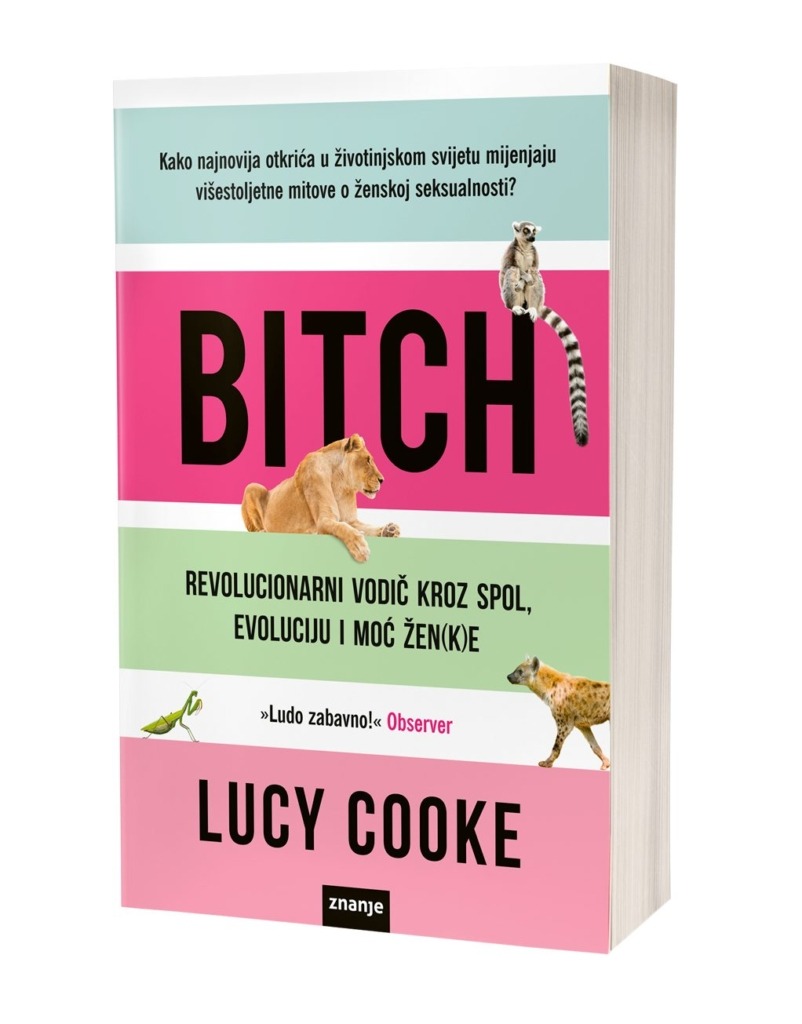I firmly believe there is not a woman on Earth who has not, at least once, experienced the projection of some stereotype about women. But stereotypes are meant to be broken. Unfortunately, I have felt this on my own skin, and more than once; in society, in jest, in the extended family, and at work. If I had a euro for every time it was expected that a woman would make coffee at a business meeting, I would be wealthy. And if I had one for every suppressed memory, I suppose I wouldn’t have to work for a living, at least not for money and survival.
Bitch
About two years ago, I read a review in a British media outlet about the book “Bitch,” and it immediately intrigued me. The author of the article dynamically dissected the book and drew comparisons between its conclusions and Darwin’s scientific theories with those of Lucy Cooke. Scientist Lucy Cooke has written a book that presents a passionate, humorous, and revolutionary view of the empresses of the animal kingdom. In her book, Cooke explains what it means to be a woman. The women in “Bitch” defy conventional expectations regarding their bodies, brains, biology, and behavior. Whether Cook is exploring female albatross pairs that raise young together, murderous meerkat mothers, or female lemurs from Madagascar that physically and socially dominate their males, Lucy Cooke leads us through a new evolutionary biology, one where females can be as dynamic and interesting as any male. “Bitch” is an absolutely fascinating book that dismantles stereotypes and myths about females and women. This is a book that brings revolutionary discoveries, which are mirrored from the animal world into the human one.
In those few sentences reviewing the book, I immediately recognized myself; in fact, I recognized most of the women in my life, no matter how different they may be from one another. By reading the book, I can only conclude that Lucy Cooke has succeeded in one different generalization: the one that recognizes the false stereotype shared by the female gender, across all species, and with one stroke—through an empirical, scientific approach—destroys it. Lucy Cooke, “Bitch”—noted on my reading list. It took just over two years (so many books, and so little time!) before my editor surprised me with the wonderful news that I had the opportunity to interview the author! I read the book in two days, and that was only because it was a workweek, and I couldn’t devote the entire day to the book. I had to stop because a sleepless night in the middle of the week, just before going on vacation, is not the best decision.

Photo: Znanje
At the beginning of the interview, we recognized each other as two women who had experienced disappointment early in life as female individuals. She recalled lectures where the difference between females and males was emphasized; males are dominant, competitive, promiscuous, while females are submissive, monogamous, mothers. And that cannot be further from the truth, both in the human and animal worlds. Did you know that female moles dig harder, more skillfully, and faster because they have—testes? I didn’t. But the information Lucy shared with me in our conversation (and also mentions in her book) made sense and shattered all stereotypes. For example, moles must dig strongly and robustly to survive underground, and this is facilitated by their ovaries, which mainly consist of testicular tissue that does not produce sperm but does produce testosterone, the hormone responsible for that ability. Crazy, right?! And extremely interesting. During her zoology education, Lucy learned about the binary division of sex; bodies, brains, behaviors, everything… And that’s how she came up with the idea to write the book: “A series of events indicated to me that women were misclassified in science; there was an obsessive need to categorize things into binary categories.” Lucy decided to correct this, and she succeeded. With her scientific discoveries and confirmations, she started a revolution in science. It doesn’t matter whether it concerns birds, humans, elephants, or dogs; she had them all in mind when she began writing the book. “I didn’t know that the (female) story was so big, that the revolution would be massive. I started investigating stories that I knew were misrepresented, and things ‘spilled over.’ The whole thing became bigger and bigger, and then I started worrying that I was—right. Why has no one addressed this before?” Lucy asked in the book and aloud during our conversation. I think she still asks herself that from time to time. The patriarchy and patriarchal understanding of the world have largely contributed to this perception, defining the way humans understand nature.
Of course, there are species that behave in a patriarchal manner, for example, baboon monkeys. Their males are dominant, create harems of females, and the females are submissive, not competitive; the males hold all the power over them. And as with everything in life, even in such communities, not everything is as we think it is. “We view the animal kingdom through a patriarchal lens; that’s how we’ve always been taught,” Lucy emphasizes and continues: “In the animal world, there is only one constant, and that is diversity. There is an incredible diversity of ways of being, and that diversity is the driving force behind progress. If everything were always the same, it would stop. There would be no development, no progress.” These few sentences open our eyes. Besides being scientific, they are so obvious and unavoidable. In her book, Cooke offers numerous examples, from cannibalistic spiders to reef fish that change sex, in order to dispel many myths about binary sex roles, most of which are linked to the great bard of science, Charles Darwin. According to Darwinian dogma, males fight each other for possession of females, strategize, and behave promiscuously, driven by the biological imperative to spread their (abundant) seed. Females are monogamous and passive; they patiently wait for their large, energy-rich eggs to be fertilized by sperm and then selflessly give everything for their offspring. Darwin was a genius, and I think he is turning in his grave,” she mentioned a second before I uttered his name. “I felt bad for pointing out such a horrible mistake because that scientist, that man was extremely meticulous. He did not publish ‘On the Origin of Species’ for eleven years! Eleven years studying shells because he wanted to get everything right, he was very afraid that his work would not be accepted, nor him as an expert. He wanted to be absolutely sure about everything. And he was sure and right about many things, but he was wrong about women. And there he caused quite a bit of damage, unintentionally, unconsciously.” We both concluded that Darwin was from “another time” and that he could not be blamed for that.
This is what Lucy considers a powerful message: if someone as brilliant, meticulous, and cautious as Darwin can be caught off guard by cultural bias, then we all must realize that we view the world through a specific pair of glasses unique to us and that much more is happening around us than we understand or think we understand. “What surprised me the most was discovering my own bias! I was convinced that it was a linear, tidy, expected, and predictable process, but it’s chaos. I discovered that the reasons we have so much diversity are actually the genes that create males or females, and there are 60 of them, and they are the same genes that create testes or ovaries. They simply have their own rhythm, their own melody, and that completely fascinated and recalibrated me.” The shock was so great that Lucy had to call the scientist who revealed this to her three times. The mole is an example of that chaos. A common animal, a resident of every continent, that lives a fascinating life. The whole process of creating a male or female is chaotic, and at the same time, it’s about fine-tuning the genes.

Photo: Lucy Cooke
At that moment, I couldn’t help but recall the Olympic Games and all the fuss that arose around boxer Imane Khelif, which confirms her thesis that runs throughout the book. When we look at the animal kingdom, we understand the meaning of diversity and the fact that no variation is abnormal. Everything is normal; Imane, the mole, and the hyena with a huge clitoris that looks like a penis. All of these are normal variations. There are people, individuals who find themselves between binary categories, and that is perfectly fine; that is normal. “That is magnificent,” Lucy emphasizes. Where does the problem arise and how can it be solved? “There is a system that does not fit into two unique boxes, but we need such fitting. The problem is that sex is complicated. Sex, gender, sexuality, all of it is a large spectrum with many manifestations. Unfortunately, culture has long said that sex is binary, and now we find ourselves in this problem while trying to understand how to move forward. I truly feel sorry for athletes who are observed as experimental samples and are forced to discover things about themselves that are really private, and then they go through huge debates about it. I feel for them deeply.”
Sexuality is a topic that, I believe, does not bypass anyone and is intriguing. I was curious about how society’s perception of female sexual experience translates from the animal to the human world and vice versa. I often mention in such discussions what I know for certain, which is that dolphins mate for pleasure, not just for reproduction. Many do not believe me when I mention this, and these are highly educated people who are curious, interested in the world around them, and not afraid of the different and the new. “That patriarchal idea that sexuality must be controlled and that women are not sexual, that they engage in sex only for reproduction, is wrong, and there are examples throughout the animal kingdom,” she explains. “There are many species where females do it for pleasure. Humans are sexual beings. If you think about it, sex is a way to bond. And there are cases where women refuse sex and find ways to get rid of men, in which they have an almost instinctive drive.” And that is so beautiful! Love and sexuality do not have to be tied to reproduction. The book “Bitch” was written for those who feel ashamed of their own femininity, their own sexuality, and who do not understand that they are the ones who shape their identities. Just like in nature.
There are fascinating examples throughout the book. I loved the one about the blue-footed booby bird. Its courtship dance is a colorful display of physical traits; the males present their feet as a signal of good health and vibrancy to attract females. And then the females can choose the male they want! Did you know that among humans, the sexual selection process is extremely important, and that a lot of women use it as a shield to protect themselves? If you recognize something similar in yourself, that is a valuable lesson. But it’s easier said than done. I fully understand that we often settle for what is in front of us instead of what we truly want or what can fulfill us. It requires a lot of courage to break free from inherited chains and for women to realize that they must be the ones in charge of their lives.
Now, back to dolphins. Lucy is not the only scientist who fascinates with her conclusions and theses. Patricia (Patty) Brennan from Mount Holyoke College in Massachusetts, USA, also inspires Lucy Cooke. She is an evolutionary biologist who studies dolphins and their sexuality. Lucy explained everything in detail, transferring this knowledge into her book. Patty confirmed to her that the clitoris of dolphins has the same number of nerve endings as in women. Yes, dolphins feel pleasure just like women, female Homo sapiens.
With her book, Lucy has sparked a revolution—her revolution is spreading and joining other “sister revolutions,” the sexual revolutions that are currently happening. “There is an understanding of the magnificent diversity of sex, gender, and sexuality and their positive roles in the evolution of all species. However, at the same time, we also see a global rise of the far right and the promotion of old-fashioned conservative patriarchal thinkers who want to turn back time and define women only as mothers, while ignoring the rights of transgender individuals and the queer community, all of which is being attempted to be erased. And that is very scary. These things are obviously happening simultaneously for some reason because patriarchy depends on binary, defined sexes. That is the ‘oxygen’ for that model of existence. If it is suggested that things are more complex than that, then these foundations begin to shake, and that becomes very frightening for the far right and patriarchal structures. I hope we will win this revolution and that the truth will come to light. Science has supported and proven it.”
Her next book is about masculinity. I don’t need to emphasize how much I’m looking forward to it. I just hope it reaches the male population so they can understand how toxic patriarchy is for them and realize and accept all the diversities of masculinity. Because that is the beauty—in diversity. And it is all normal.







